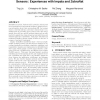Free Online Productivity Tools
i2Speak
i2Symbol
i2OCR
iTex2Img
iWeb2Print
iWeb2Shot
i2Type
iPdf2Split
iPdf2Merge
i2Bopomofo
i2Arabic
i2Style
i2Image
i2PDF
iLatex2Rtf
Sci2ools
MOBISYS
2004
ACM
2004
ACM
Implementing Software on Resource-Constrained Mobile Sensors: Experiences with Impala and ZebraNet
ZebraNet is a mobile, wireless sensor network in which nodes move throughout an environment working to gather and process information about their surroundings [10]. As in many sensor or wireless systems, nodes have critical resource constraints such as processing speed, memory size, and energy supply; they also face special hardware issues such as sensing device sample time, data storage/access restrictions, and wireless transceiver capabilities. This paper discusses and evaluates ZebraNet's system design decisions in the face of a range of real-world constraints. Impala--ZebraNet's middleware layer--serves as a lightweight operating system, but also has been designed to encourage application modularity, simplicity, adaptivity, and repairability. Impala is now implemented on ZebraNet hardware nodes, which include a 16-bit microcontroller, a lowpower GPS unit, a 900MHz radio, and 4Mbits of non-volatile FLASH memory. This paper discusses Impala's operation scheduling and ...
Mobile Sensor Design | MOBISYS 2004 | Sensor Network Application | Wireless Networks | Wireless Sensor Network |
| Added | 24 Dec 2009 |
| Updated | 24 Dec 2009 |
| Type | Conference |
| Year | 2004 |
| Where | MOBISYS |
| Authors | Ting Liu, Christopher M. Sadler, Pei Zhang, Margaret Martonosi |
Comments (0)

